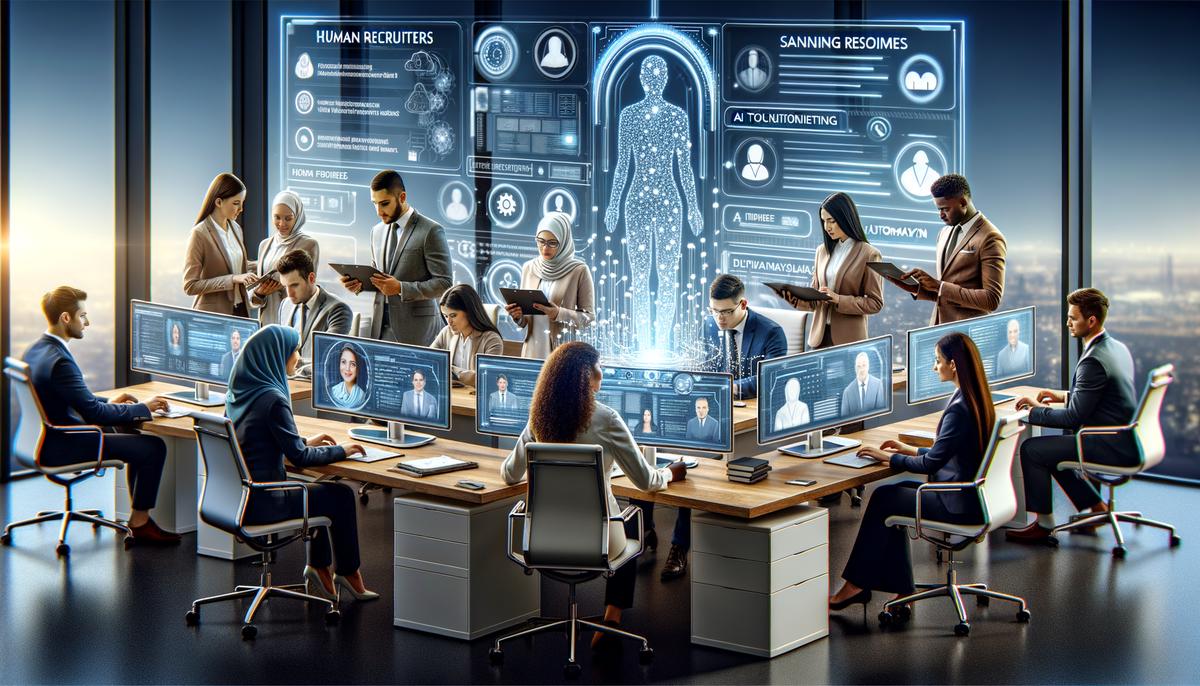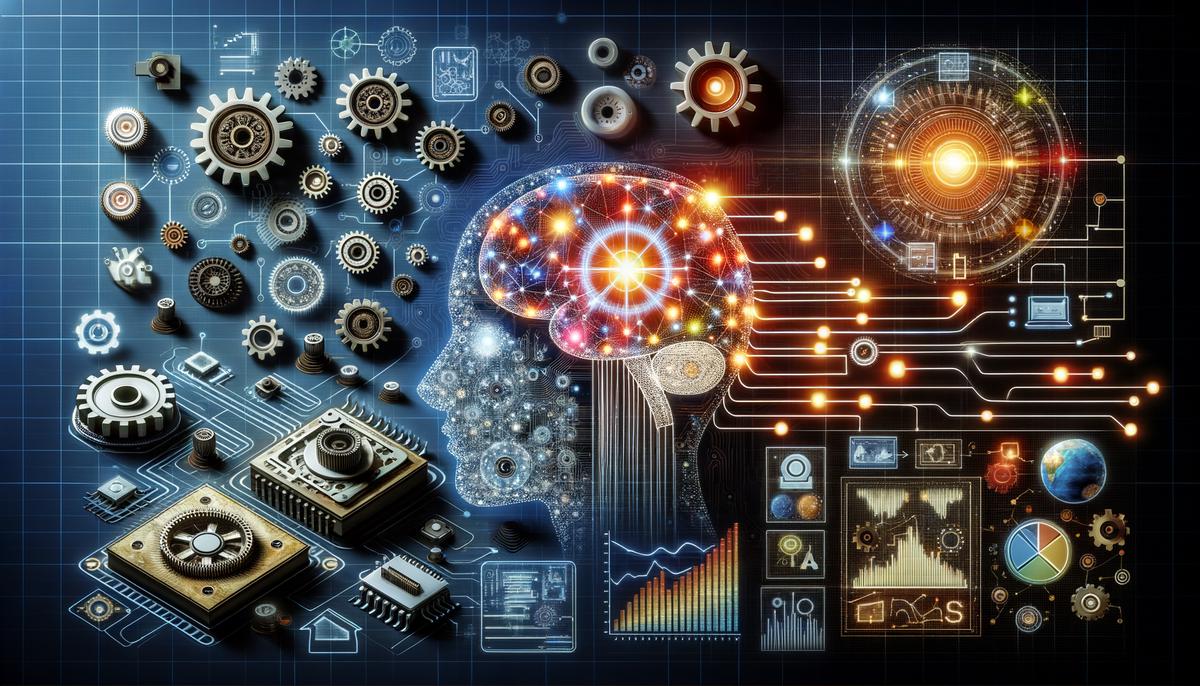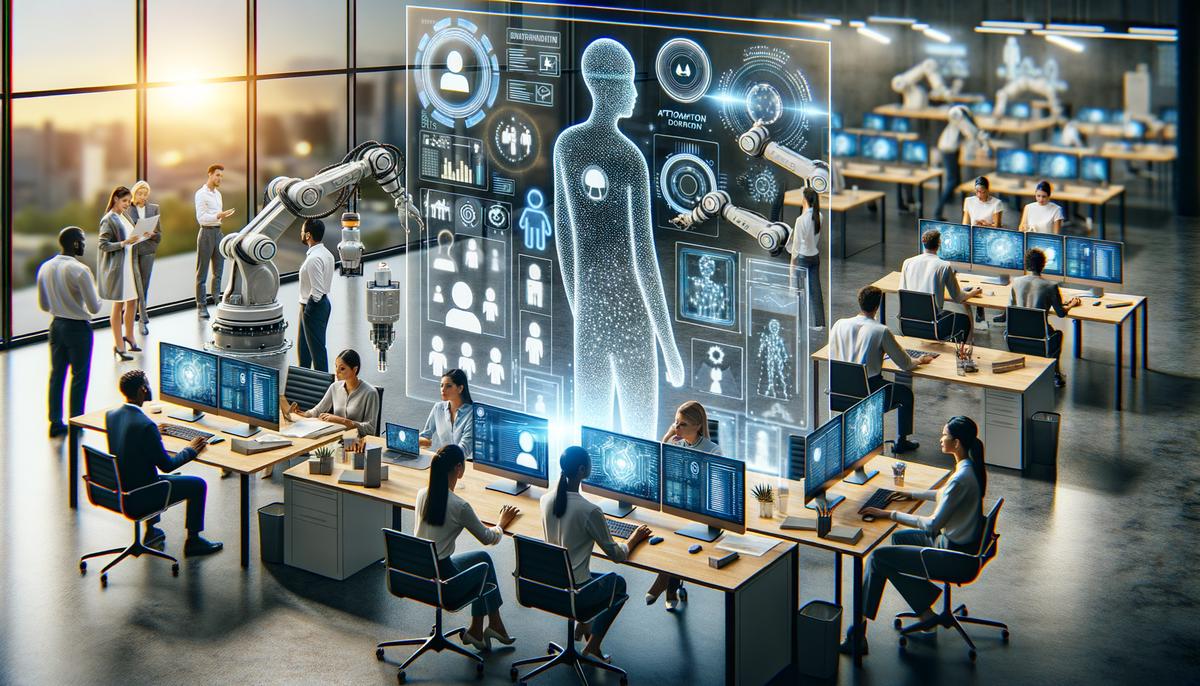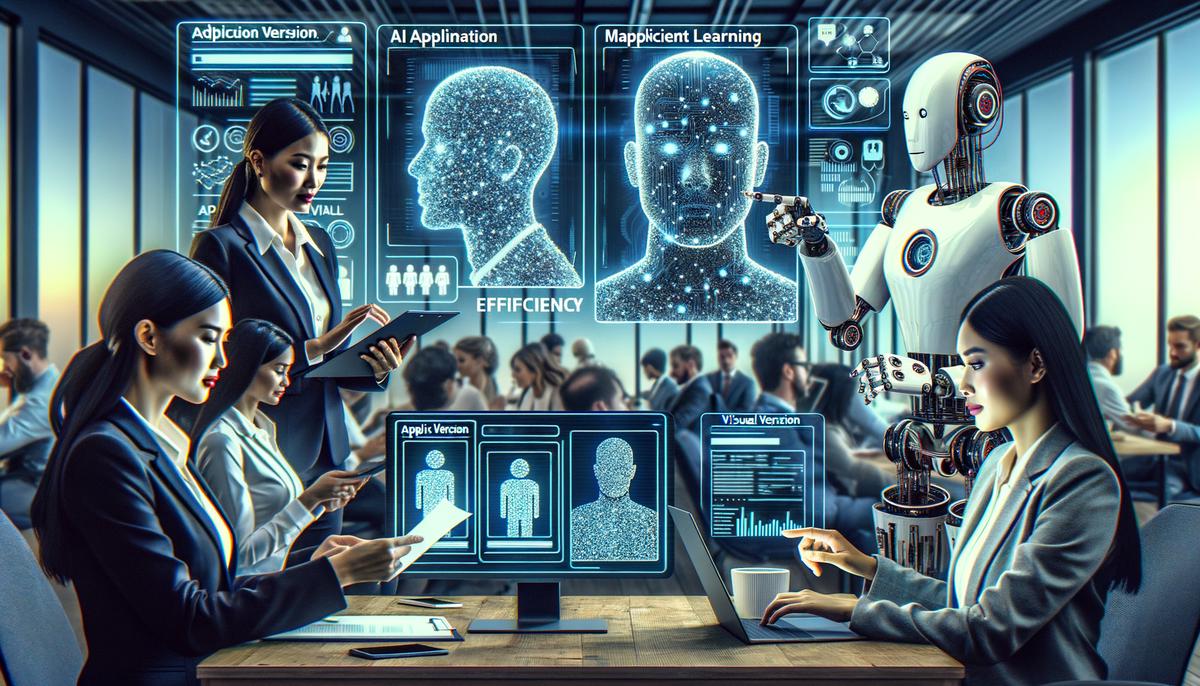Our Blog
Artificial Intelligence (AI) and automation are often spoken of in the same breath, suggesting a blend of technology that is reshaping the landscape of various industries, including staffing. The distinction between these two, however, marks the beginning of understanding their individual contributions and collective impact. This conversation sheds light on how AI’s cognitive capabilities and automation’s efficiency play pivotal roles in refining recruitment processes, making them more efficient and equitable.
Defining AI and Automation
AI’s cognitive capabilities closely mimic human thought processes to evaluate candidates based on various factors, including their skills, experience, and potential cultural fit within a company. Meanwhile, automation handles the repetitive tasks, such as sending out application confirmation emails or scheduling interviews, thus saving precious hours that recruiters can then devote to more strategic activities like candidate engagement and relationship building.
The real magic starts when AI steps in to analyze patterns within large datasets, something that simply speeds up thanks to automation alone could never achieve. Consider an AI system that learns over time which candidates succeed in specific roles based on historical data. It’s like having a dedicated researcher continually refining what the ideal candidate looks like – a task that requires a depth of analysis and learning capabilities far beyond the scope of basic automation.
On the flip side, automation’s strength lies in its ability to crank out routine tasks without fatigue, errors, or coffee breaks. This consistency ensures that every applicant receives timely communication and that each interview is scheduled without double-booking, creating a smoother overall candidate experience. Automation doesn’t learn or adapt from these interactions; it simply follows the preset rules with unyielding consistency.
AI also offers unique benefits in its ability to help overcome unconscious biases in the recruitment process. Since it can be programmed to ignore demographic factors such as name, age, gender, or ethnicity, it focuses solely on the qualifications relevant to the job. This leads to more diverse and inclusive candidate shortlists than humans might produce, all thanks to AI’s ability to stick strictly to predefined performance and skill metrics without personal biases swaying its judgement.
The essence of AI in staffing isn’t just about reducing recruitment times or making the process more cost-effective; it’s also about enhancing the quality of hires. By drawing on expansive datasets to identify patterns and predict outcomes, AI provides staffing professionals with insights that would be near impossible to develop through human analysis alone, ensuring candidates aren’t just a good fit for the job today but will likely succeed long-term.
Automation ensures that the volume of recruitment activities doesn’t overwhelm human recruiters. By tackling time-consuming administrative work, it frees them up to focus on building relationships with candidates and making nuanced hiring decisions — tasks that, at least for now, require a human touch.
Ultimately, while AI and automation are individually powerful, their true potential is only realized when they’re used in tandem within the staffing process. This blend of human-like analysis and tireless efficiency redefines what’s possible within recruitment, promising more effective hiring processes and better outcomes for businesses and candidates alike.

Efficiency Gains
Automation swiftly sifts through applications and resumes, pinpointing candidates that meet specific job requirements without delay, significantly reducing the time between posting a job opening and finding the right candidate. By handling the initial stages of the selection process, automation ensures that only the most suitable applicants move forward, making the entire recruitment cycle faster and more efficient.
AI adds another layer of sophistication by predicting candidate success within specific roles. By examining historical hiring data and employee performance, AI models can forecast which candidates are likely to excel, reducing the risk of poor hires that can be costly to the company. This predictive analysis not only streamlines the hiring process but also enhances the precision with which staffing decisions are made.
Automating the scheduling of interviews and communication with candidates eradicates delays often caused by manual coordination. Tools powered by AI and automation can automatically arrange interviews based on the availability of both candidates and hiring managers, send reminders, and follow up on next steps. This level of efficiency ensures candidates remain engaged and informed throughout the process, improving their experience and reducing the likelihood of losing top talent to competing offers.
AI-driven chatbots can handle initial inquiries from candidates, providing immediate responses to common questions and guiding applicants through the early stages of the application process. By offering real-time interactions, these chatbots help maintain the interest of potential candidates and prevent drop-offs due to perceived neglect or prolonged waiting periods for responses.
Automation streamlines the onboarding process for new hires. Once a candidate accepts an offer, automated workflows can kick off the preparation for their start date, from setting up IT access and email accounts to scheduling orientations and training sessions. This ensures new employees are ready to hit the ground running, contributing to organizational goals with minimal delay.
Automated candidate relationship management systems efficiently maintain a pool of past applicants for future openings. By automating recruitment marketing efforts and candidate re-engagement emails, organizations can quickly tap into a ready supply of vetted candidates when new roles arise, decreasing the time it takes to fill these positions.
Analyzing feedback from hiring managers and candidates through automated surveys provides insights that can continuously improve the recruitment process. AI algorithms assess this feedback in real-time, identify areas for enhancement, and adjust recruitment strategies accordingly, fostering a cycle of constant improvement.
By leveraging AI’s data analytics capabilities, staffing processes become not only quicker but smarter. The technology identifies successful hiring patterns and integrates this intelligence to refine job descriptions, optimize posting strategies, and even suggest adjustments to interview questions based on what has been most indicative of candidate success in similar roles.1
The integration of AI and automation transforms staffing from a traditionally time-consuming and potentially biased process into a streamlined, efficient, and more objective operation. With these technologies, organizations can not only fill vacancies faster but also ensure they’re selecting candidates who are best suited for success in their new roles.

Candidate Experience
AI and automation elevate the candidate’s journey from the moment they apply to the moment they’re hired. AI’s presence in recruitment means immediate acknowledgement of application receipt and constant updates on where they stand in the hiring process. This level of communication keeps candidates engaged and informed, reducing uncertainty and improving their overall experience.
Automation’s ability to handle scheduling interviews makes the process seamless for both candidates and hiring managers. Instead of the tiresome back-and-forth emails to find a suitable time, candidates can choose their preferred slot from available times directly linked to the recruiter’s calendar. This not only speeds up the process but shows respect for the candidate’s time, enhancing their perception of the company.
AI also plays a crucial role in personalizing the recruitment process. Based on a candidate’s resume and interactions, AI can tailor job recommendations, content, and advice, making their experience feel much more bespoke than traditional methods. It shows candidates that the company sees them as more than just a number, increasing their interest and engagement with the brand.
During the onboarding process, automation simplifies:
- Paperwork
- Training schedules
- First-day logistics
This efficiency allows new hires to settle into their roles more quickly and smoothly, making a great first impression of the organization’s operational excellence. This streamlined start helps build a positive working relationship from day one.
With automated candidate relationship management systems, even those not selected for a position have a more positive experience. These systems can offer constructive feedback, additional resources, or alternative job suggestions, thereby maintaining a positive relationship between the brand and the candidate. This thoughtful touch can turn a rejected applicant into a future talent pool or even a loyal customer, revealing the broader impact of AI and automation on brand perception.
By leveraging AI to analyze candidate performance metrics and recruitment strategies, organizations ensure not just a data-driven approach to hiring but also an ongoing enhancement of the candidate experience. Continuous optimization based on real-time feedback shows candidates that their opinions and experiences matter, fostering a transparent and dynamic relationship between them and the organization.
In this digital age, candidates expect a recruitment process that’s not just efficient but also considerate and responsive. AI and automation are proving to be game-changers in this aspect, not merely accelerating the hiring process but also significantly refining the candidate journey. They set the stage for a more humane and personalized interaction—even in the most automated phases of recruitment—showing that technology, deployed thoughtfully, elevates human experiences rather than diminishing them.

Ethical Considerations
One ethical challenge AI and automation face in staffing is the risk of perpetuating systemic bias, despite their ability to counteract human prejudices. When AI systems learn from past hiring data, they might unwittingly favor characteristics that reflect historical inequalities. This situation raises questions about the fairness and inclusiveness of AI-driven recruitment processes.
Candidate privacy and data security is another area of ethical concern. AI and automation systems process vast amounts of personal information, from contact details to professional achievements and even personality assessments. Ensuring this data is handled with respect for privacy, used ethically, and protected against breaches is paramount. Candidates entrust organizations with sensitive information, believing it will be used solely to assess their compatibility with a role. Misuse or negligence can lead to significant trust issues and potential legal consequences.
The dehumanization of the recruitment process is a further ethical implication. While AI and automation bring efficiency, there’s a risk they could strip away the personal touch that is crucial in building meaningful employer-candidate relationships. For many, a job search is a highly personal endeavor, and feeling reduced to data points assessed by algorithms can be alienating. Ensuring technology aids the recruitment process without diminishing the human empathy and understanding at its core is essential.
Transparency in the use of AI and automation in recruitment raises ethical considerations. Candidates have the right to understand how decisions about their applications are made. If AI algorithms play a significant role, organizations need to ensure these decisions are transparent and explainable to those affected by them. Black-box algorithms that make decisions without clear rationale are ethically problematic, contributing to trust erosion in the recruitment process.
Maintaining a balance between efficiency gained through AI and automation and preserving human empathy in recruitment processes is also ethically significant. Automation can easily handle scheduling interviews, but should it be responsible for delivering bad news to a candidate not selected for a role? The impersonality of receiving such feedback from a machine might be perceived as insensitive. It’s crucial to discern which aspects of recruitment can be automated without sacrificing the compassionate elements that reflect an organization’s values.
Accountability for decisions made by AI and automation systems in recruitment remains a challenging ethical issue. When a candidate is unfairly evaluated or discriminated against by an automated system, it raises questions about liability. Pinning down accountability—whether on the creators of the AI systems, those who implement them, or the technology itself—poses complex ethical and legal challenges.
Overall, while AI and automation hold the promise of revolutionizing staffing, ensuring these technologies are wielded with a keen awareness of their ethical implications is crucial for fostering equitable, respectful, and human-centered recruitment processes.

In conclusion, the synergy between AI and automation in staffing processes is not just about streamlining operations or making them more cost-effective. The crux lies in their ability to transform recruitment into a more data-driven, unbiased, and human-centric process. By leveraging the strengths of both technologies, organizations can achieve a balance between efficiency and empathy, ensuring that the recruitment journey is as rewarding for candidates as it is for employers.
- Cappelli P. Artificial intelligence in human resources management: challenges and a path forward. California Management Review. 2019;61(4):15-42. doi:10.1177/0008125619867910